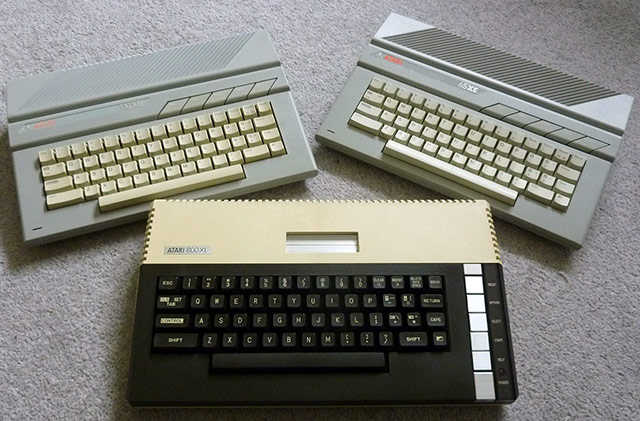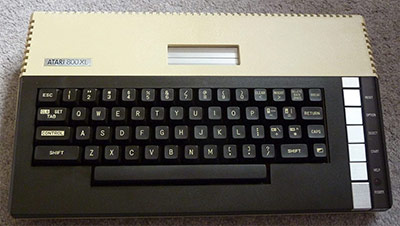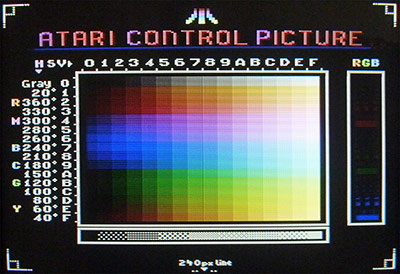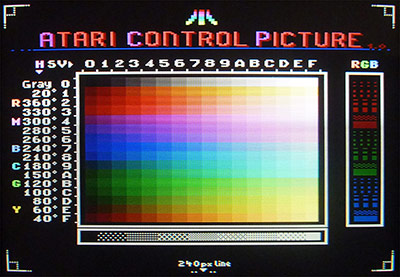
Atari Stuff
of which there is much...
I thought I'd do a summary of a load of Atari stuff, because so much has been happening. I'll be covering how what we do to them and why. Starting with how we pick them up.
Here in the UK we don't really have a tendency to keep things when we trade up. We don't have yard sales, car boot sales died out a few years back and our thrift stores (basically pawn shops or charity shops) tend not to get vintage electronics in them. All of which leaves us with eBay or Gumtree as our primary sources for getting out mitts on old gear. Another not so great fact about the UK is that it is cold and damp, so lofts and garages, where these electronics inevitably end up before making their way to eBay / Gumtree, are not really ideal places to store electronics.
Now we (as in Cleggy and I) are fortunate in that, because we've long been into fettling things and we are both massive geeks from way back when, have the ability to research, restore and repair things. All of which comes in handy as now that we're in an era where the nostalgia is biting for retro gaming and computing, everyone and their cat is finding old kit that they didn't sell on and has decided to cash it in for big bucks. The thing is, many of them don't have analogue TVs any more, so cannot test them. Many of them also don't put a lot of effort into selling their stuff. This is what we want as when they do, they want stupid money for 30+ year old hardware.
Restoring & Repairing Old Kit
Which is where we come in. We target spares or repair, untested and 'it worked when I put it up in the loft 20 years ago' sales. All of the previous comments can be translated to: "It probably doesn't work, but I don't have the means or CBA to put any effort in, just send me some money and I'll wash my hands of it". Which is what I want, and here's why.
I haven't got pics of exhibit 1 sadly, but man it was a mess. This was a particularly scruffy looking Atari 7800 console, described as rough and with rust showing through the bottom. I picked it up for buttons and it was as rough as it looked in the advert. It was worse when we took the lid off with the RF shielding being mostly rust, that just went in the bin. There'd obviously been a lot of moisture around as that rust had leeched into the mainboard and a lot of the components. The regulator was hanging free and was on the brink of it's legs breaking also. It took a LONG time to clean up... When we were somewhere near done we plugged it all in and miraculously it worked. Which means we then move on to the restoration.
Previously I'd also had an 2600jr that I got for next to nothing that turned out to be faulty to the point that it became a spares machine. As the rust had made it into the switches and joystick ports, we removed those from the donor 2600 and swapped them onto the 7800. The buttons were also shot, but you can still buy those so we got a set. All the electrolytic caps were swapped, the regulator and the heatsink was attached as it should be. Finally a new power socket as the 7800 has a bespoke connector and we want to use a modern PSU. That got the machine working nice. The casework was then washed and we did what we could with it. It's never going to win a beauty contest, but it looks a lot better than it did.
I wish I had the original eBay picture of the 65XE above as it looked even worse than it does in my pic. The 800XL came to being because I killed the 65XE and bought the 800XL to replace it, then Cleggy found the fault and repaired the 65XE leaving me with two 8-Bit Ataris. The 65XE I expected to be a non-worker as it looked so rough. It did however power up, but two directions didn't work on the joystick ports, which was traced back to a faulty PIA IC. That got swapped and the machine seemed to now be rocking. The 800XL was miraculous in that it's the only 8-Bit that fired up first time with no faults (Cleggy's 130XE had a faulty GTIA, dodgy keyboard membrane and a broken joystick port). The reason I went for that particular 800XL was that, other than looking dirty, it looked entirely intact and pretty good underneath the dirt. There were other equally non-flattering pics of it, which backed this up. Also, and you'll be noticing a theme here, it sold for relative buttons.
Once working the procedure is the same with most things; check the electrolytic capacitors for leaking as they can corrode the PCB and components around them, or bulging, which is another sign that they're shot. Japanese caps tend to be the most reliable and long lived, Chinese the least. The other thing we try to do is bin the old PSUs. Many old power supplies are encased in resin and unrepairable. I don't trust many old PSUs, some less than others for other reasons (the C64 PSU is a computer killer, the BBC PSU has caps in it that WILL fail and will also kill the computer). To this point, none of my vintage computers are running on their orginal PSUs. Consoles seemed to fair better, but they can also be problematic.
Next is cleaning and restoring. Getting the brush out on the PCB and some IPA if it's particularly bad. For the casing, that is almost certainly getting stripped and washed in soapy water. All the keys come off the keyboard and join them, the keyboard itself underneath gets brushed and in the case of the 65XE, it got a new membrane as it was a bit flakey and a dude on Atari Age was re-manufacturing them, so it'd have been rude not to.
For the 800XL that was all that was required, I don't consider it's yellowing to be bad enough to Retrobrite it. Indeed it still had the plastic protection on the cart slot, it cleaned up nice. The 65XE however got the full Retrobrite treatment, keys and all. It's not fun, but done right the results can be stunning.


after. Yes, they are the same machines
Coming on to my new 7800... I bought another, usual MO. This one caught my eye, but it was Cleggy who noticed something about the advert photo that I had not. The metal strip in 7800s is prone to picking up marks and damage. The rusty one looks absolutely awful in that respect. This one, appeared to still have the protective plastic on it, which makes it look bad, like they all do, but underneath there were chances that it was actually much, much nicer. It looked a bit grubby in the pics but overall to be in good condition. The shield through the slats in the bottom looked nice and shiny, which hints that it's not been kept anywhere damp. As usual it had no PSU or controllers and was sold as not working.
However it did work, and was in actually bloody marvellous condition. It didn't even need washing, a wipe down with a damp cloth and peeling back the protective film revealed an almost pristine 7800. Inside it was just as nice. Sure it needed a little attention. One of the screw moldings had broken, and bits of it were rattling around in the case. That was all collected and epoxied back into position. Also the power button was a little worn, but I still had some of those left from the pack I bought for Rusty, so that wasn't a big job. Otherwise it was the same old thing. It got new caps, I swap the reg on these also because of the way they're mounted, then I really securely mount that heatsink.
One thing to note is that after swapping the caps, the tuning had drifted, so we went through a head-scratching phase trying to figure out how it was possible to screw up replacing three caps and a regulator, especially when it all probed just fine. Only to last resort try to re-tune the TV, and there it was.
Sympathetically Upgrading Old Kit
Purists might leave it there. Hell they'd probably not like the Retrobrite. I however, have been modifying computers and consoles since I was a kid. Back in the day I'd transplanted my ST into a tower case and fitted a 16Mhz CPU for example. I'm not precious, and there is a thing that Atari did not do very well that back in the day we didn't notice because we were plugging this kit into domestic TVs via RF.
Video output on most Atari products prior to the Atari ST is shit. To the point that sometimes it looks like they went out of their way to sabotage it. The 800XL for example, generates Luma and Chroma (S-Video). It's right there, it's just not connected to the socket. It might be because it is possible that it'd interfere with the composite out, but again, there's no reason it had to. There are also some bizarre part values kicking around the video output stage. This can all be rectifed surprisingly simply with a few pulled parts and part substitutions. I've just left S-Video connected and disconnected everything else, but it is 80,000,000 times better than standard output. It's not perfect, certainly if you run it through a LCD panel it'll still look bad, but on a revealing but awesome Sony PVM, it looks surprisingly good.

S-Video mod, RF Modulator removed, that'll be back later...
Video mods are required on almost all old Atari gear if you don't have a TV with an RF analogue tuner. Rusty got a UAV mod, Shiny got a Magic Knight one (both on Atari Age). Output from both is massively better than stock, though PAL 7800s still tend to exhibit a fair bit of dot crawl on solid blocks of colour (only in 7800 mode though). It's likely flaws in the layout of the machine that no-one really saw back then, so it was good enough. I decided to socket up Shiny, because it was so nice, I just ran wires out the back of Rusty.
Turbocharging Old Kit
Originally I upgraded my 65XE to 130XE spec by adding some more memory to it (you can only do this with a UK 65XE as it's actually a 130XE just with bits missing, the US 65XE is stripped down and cannot be upgraded in this way). It worked nice, but the A8 has some really nice kit available for it these days that complement the machine nicely without making it something it never was. The best of those, IMO, are the Ultimate 1MB upgrade and the Dual Pokey stereo upgrade (both available from Lotharek in Poland). To the point that I upgraded both my A8's with them. There are other options, but IMO they take the machine away from what it is. That said, it is impressive to watch an A8 run an Amiga demo better than an Amiga can...
I've only got pics of Cleggy's 130XE guts as mine is way scruffier (it was the first), and I'm a tart. The extra Pokey IC's were salvaged from 7800 Ballblazer carts. Get 'em while you can as that's starting to get pricey! Commando carts (the other cart with a Pokey in it) are already getting to be too much. This is also where we put the modulators back, but in re-purposed form. We don't like drilling old computers, so try to do it as little as possible or as discreetly as possible if we have to. To get the stereo out, we needed a jack somewhere. Now there's a nice big hole where the RF out used to be, with a nice box that holds the jack. Seemed like a neat solution, so we gutted the modulators and took a blow torch to the RF jack to melt the solder that welded it into the casing. Once that popped out you've got a lovely, perfectly positioned hole in which to install a 3.5mm stereo jack plug. Neat!
Finally Sorting that Video Out
Then I became aware of the Sophia video board got in touch with Simius who makes them on AtariAge and snagged a RevB RGB version. I broke my rule of not cutting holes in the back of old kit for this one. But I think you'll agree that the quality of the output was worth it.


modded S-Video on the left, Sophia RGB on the right
[ back ]